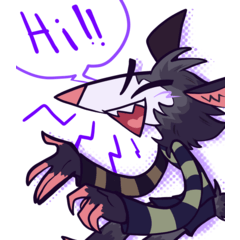1. Preferences and Brush Preparation
▼This is my finished illustration.
・ Artist profile: isuZu
I mainly draw card illustrations, as well as illustrations and covers for books. I love drawing food.
[1] Work environment
First, I will explain my work environment in Clip Studio Paint.
■ Creating a new canvas
I create a new canvas from [File] menu > [New] with the following settings: A4 Size, 350 dpi, white paper.
Note: For professional illustrations too, the designated resolution of color prints is often 350 dpi to 400 dpi or higher.
■ Organizing the color palette
I place the Navigator, Information, Color, Layer Property, Layer, History, and Auto Action palettes at the right side.
I hide all the unnecessary palettes related to color.
I usually pick up colors with the Eyedropper and adjust the color using the color slider, or use some of the colors from the color set. Therefore, my coloring basically only requires these two palettes.
In this lesson, I will create the illustration with RGB, so I set the color slider to RGB. I don’t use any other special settings.
■ Organizing the Tool palette
I place the settings for tools, brushes, and brush-related palettes at the left side.
To make management easier, I move all my brush tools from the [Tool] palette to a single sub tool group.
(Hereafter, I will refer to all Pencil, Pen and Brush tools as “brushes”.)
[2] Preparing the brushes
There are tremendous numbers of brushes in Clip Studio Paint, but I won’t use all of them.
Therefore, I duplicate the tools that I use frequently, and put them together in a sub tool group named “My Pens”.
・ Creating custom pen (“My Pens”)
I right click the [Sub Tool] and select [Duplicate sub tool].
Then, I click [OK] on the [Duplicate sub tool] dialog box.
The brush names are based on the original brushes.
・ Creating custom erasers (“My Erasers”)
Like the brushes, I put the erasers that I use frequently together in the “My Erasers” sub tool group.
You can make any brush into an eraser by changing the [Tool Property] > [Blending mode] to [Clear]. Using this technique, I created some customized erasers called brush erasers.
See the details of the tool property in the image below.
・ “Hard eraser 1” tool > Former [Brush] tool > [Darker pencil]
Property changes: Hardness of 90
・ “Hard eraser 2” tool > Former [Eraser] tool > [Eraser] > [Rough]
Property changes: None
・ “Soft eraser 1” tool > Former [Eraser] tool > [Eraser] > [Soft]
Property changes: Effect source settings, turned anti-aliasing off, set hardness to 51, set stabilization to 4
・ “Soft eraser 2” tool > Former [Eraser] tool > [Eraser] > [Soft]
Property changes: Turned anti-aliasing off
This how the brushes look.
Then, I go to the [Sub tool detail] palette and click the eye icons beside [Brush Size], [Opacity], [Blending mode] and any customized settings so that they show up in the [Tool Property] palette.
Hint:
You can use the [Sub Tool Detail] palette to edit the selected sub tool’s settings in more detail than the [Tool Property] palette.
For more information, please refer to the following article.
I also change any settings set to “Show indicator" to “Show slider".
That’s all for the explanation about my canvas and settings.
I save the canvas as a clip file once with [File] > [Save].
Now I've finished preparing to start my drawing. I will start drawing rough sketches from the next part.
























Comment